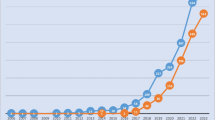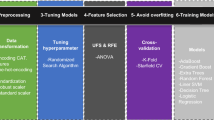Abstract
Distributed denial of service (DDoS) attacks disrupt the availability of cloud services. The detection of these attacks is a major challenge in the cloud computing environment. Machine learning models can be used to detect these attacks efficiently. In this work, a hybrid machine learning model based approach to detect these attacks is proposed. Firstly, a hybrid machine learning model using extreme learning machine (ELM) and adaptive differential evolution is proposed. In the proposed model, input to hidden layer link weights, and hidden layer biases of ELM are optimized using adaptive differential evolution while weights of links between hidden and output layers are analytically determined. The adaptive differential evolution is modified to choose the apt crossover operator during the evolution process. After that, a DDoS attack detection system using the suggested hybrid model is proposed for cloud computing.. Three state-of-the-art datasets NSL-KDD, ISCX IDS 2012, and CIDDS-001 are used to evaluate the performance of the proposed attack detection system.













Similar content being viewed by others
Data Availability
NSL-KDD and ISCX IDS 2012 datasets used in this study are available in the UNB CIC repository: https://www.unb.ca/cic/datasets/index.html. CIDDS-001 dataset is available at Coburg-university website: .htmlhttps://www.hs-coburg.de/forschung/forschungsprojekte-oeffentlich/informationstechnologie/cidds-coburg-intrusion-detection-data-sets.
Code Availability
The code of the current study is available from the corresponding author on reasonable request.
References
Huang, G. B., Zhu, Q. Y., & Siew, C. K. (2004). Extreme learning machine: A new learning scheme of feedforward neural networks. Neural Networks, 2, 985–990.
Ding, S., Zhao, H., Zhang, Y., Xu, X., & Nie, R. (2015). Extreme learning machine: Algorithm, theory and applications. Artificial Intelligence Review, 44(1), 103–115.
Rakha, M. A. (2004). On the Moore-Penrose generalized inverse matrix. Applied Mathematics and Computation, 158(1), 185–200.
Zhu, Q. Y., Qin, A. K., Suganthan, P. N., & Huang, G. B. (2005). Evolutionary extreme learning machine. Pattern Recognition, 38(10), 1759–1763.
Cao, J., Lin, Z., & Huang, G. B. (2012). Self-adaptive evolutionary extreme learning machine. Neural Processing Letters, 36(3), 285–305.
Han, F., Yao, H. F., & Ling, Q. H. (2013). An improved evolutionary extreme learning machine based on particle swarm optimization. Neurocomputing, 116, 87–93.
Mohapatra, P., Chakravarty, S., & Dash, P. K. (2015). An improved cuckoo search based extreme learning machine for medical data classification. Swarm and Evolutionary Computation, 24, 25–49.
Eshtay, M., Faris, H., & Obeid, N. (2018). Improving extreme learning machine by competitive swarm optimization and its application for medical diagnosis problems. Expert Systems with Applications, 104, 134–152.
Eshtay, M., Faris, H., & Obeid, N. (2020). A competitive swarm optimizer with hybrid encoding for simultaneously optimizing the weights and structure of extreme learning machines for classification problems. International Journal of Machine Learning and Cybernetics, 11(8), 1801–1823.
Qin, A. K., & Suganthan, P. N. (2005). Self-adaptive differential evolution algorithm for numerical optimization. In 2005 IEEE congress on evolutionary computation (Vol. 2, pp. 1785–1791). IEEE.
Dong, X. L., Liu, S. Q., Tao, T., Li, S. P., & Xin, K. L. (2012). A comparative study of differential evolution and genetic algorithms for optimizing the design of water distribution systems. Journal of Zhejiang University Science A, 13(9), 674–686.
Abdul-Kader, H., & Salam, M. A. (2012). Evaluation of Differential Evolution and Particle Swarm Optimization Algorithms at Training of Neural Network for Stock Prediction. Int. Arab J. e-Technol., 2(3), 145–151.
Karaboga, N., & Cetinkaya, B. (2004). Performance comparison of genetic and differential evolution algorithms for digital FIR filter design. In International Conference on Advances in Information Systems (pp. 482–488). Springer.
Tavallaee, M., Bagheri, E., Lu, W., & Ghorbani, A. A. (2009). A detailed analysis of the KDD CUP 99 data set. In 2009 IEEE Symposium on Computational Intelligence for Security and Defense Applications (pp. 1–6). IEEE.
Shiravi, A., Shiravi, H., Tavallaee, M., & Ghorbani, A. A. (2012). Toward developing a systematic approach to generate benchmark datasets for intrusion detection. Computers and Security, 31(3), 357–374.
Ring, M., Wunderlich, S., Gruedl, D., Landes, D., & Hotho, A. (2017). Technical Report CIDDS-001 data set.
Sahi, A., Lai, D., Li, Y., & Diykh, M. (2017). An efficient DDoS TCP flood attack detection and prevention system in a cloud environment. IEEE Access, 5, 6036–6048.
Bharot, N., Verma, P., Sharma, S., & Suraparaju, V. (2018). Distributed denial-of-service attack detection and mitigation using feature selection and intensive care request processing unit. Arabian Journal for Science and Engineering, 43(2), 959–967.
Kushwah, G. S., & Ali, S. T. (2017). Detecting DDoS attacks in cloud computing using ANN and black hole optimization. In 2017 2nd International Conference on Telecommunication and Networks (TEL-NET) (pp. 1–5). IEEE.
Seth, J. K., & Chandra, S. (2018). An effective DOS attack detection model in cloud using artificial bee colony optimization. 3D Research, 9(3), 1–13.
Abusitta, A., Bellaiche, M., & Dagenais, M. (2018). An SVM-based framework for detecting DoS attacks in virtualized clouds under changing environment. Journal of Cloud Computing, 7(1), 1–18.
Idhammad, M., Afdel, K., & Belouch, M. (2018). Detection system of HTTP DDoS attacks in a cloud environment based on information theoretic entropy and random forest. Security and Communication Networks, 2018.
Mayuranathan, M., Murugan, M., & Dhanakoti, V. (2019). Best features based intrusion detection system by RBM model for detecting DDoS in cloud environment. Journal of Ambient Intelligence and Humanized Computing, 12(3), 3609–3619.
Kushwah, G. S., & Ali, S. T. (2019). Distributed denial of service attacks detection in cloud computing using extreme learning machine. International Journal of Communication Networks and Distributed Systems, 23(3), 328–351.
Velliangiri, S., Karthikeyan, P., & Vinoth Kumar, V. (2020). Detection of distributed denial of service attack in cloud computing using the optimization-based deep networks. Journal of Experimental& Theoretical Artificial Intelligence, 33(3), 405–424.
Bhardwaj, A., Mangat, V., & Vig, R. (2020). Hyperband Tuned deep neural network with well posed stacked sparse AutoEncoder for detection of DDoS attacks in cloud. IEEE Access, 8, 181916–181929.
Kachavimath, A. V., & Narayan, D. G. (2021). A deep learning-based framework for distributed denial-of-service attacks detection in cloud environment. In Advances in computing and network communications (pp. 605–618). Springer.
Xiao, L., Wei, W., Yang, W., Shen, Y., & Wu, X. (2017). A protocol-free detection against cloud oriented reflection DoS attacks. Soft Computing, 21(13), 3713–3721.
Aborujilah, A., & Musa, S. (2017). Cloud-based DDoS HTTP attack detection using covariance matrix approach. Journal of Computer Networks and Communications, 2017.
Pandey, V. C., Peddoju, S. K., & Deshpande, P. S. (2018). A statistical and distributed packet filter against DDoS attacks in Cloud environment. Sādhanā, 43(3), 1–9.
Agrawal, N., & Tapaswi, S. (2018). Low rate cloud DDoS attack defense method based on power spectral density analysis. Information Processing Letters, 138, 44–50.
Agrawal, N., & Tapaswi, S. (2020). Detection of low-rate cloud DDoS attacks in frequency domain using fast hartley transform. Wireless Personal Communications, 112(3), 1735–1762.
Gaurav, A., Gupta, B. B., Hsu, C. H., Peraković, D., & PEÑALVO, F. J. G. (2021). Filtering of distributed denial of services (DDoS) attacks in cloud computing environment. In 2021 IEEE International Conference on Communications Workshops (ICC Workshops) (pp. 1–6). IEEE.
Yoon, H. S., & Moon, B. R. (2002). An empirical study on the synergy of multiple crossover operators. IEEE Transactions on Evolutionary Computation, 6(2), 212–223.
Acan, A., Altincay, H., Tekol, Y., & Unveren, A. (2003). A genetic algorithm with multiple crossover operators for optimal frequency assignment problem. In The 2003 Congress on Evolutionary Computation, 2003. CEC’03 (Vol. 1, pp. 256–263). IEEE.
Herrera, F., Lozano, M., & Sánchez, A. M. (2005). Hybrid crossover operators for real-coded genetic algorithms: An experimental study. Soft Computing, 9(4), 280–298.
António, C. C. (2009). A study on synergy of multiple crossover operators in a hierarchical genetic algorithm applied to structural optimisation. Structural and Multidisciplinary Optimization, 38(2), 117–135.
Funding
This research received no grant from any funding agency.
Author information
Authors and Affiliations
Contributions
Gopal Singh Kushwah: conceptualization, methodology, software, validation, investigation, writing- original draft. Virender Ranga: resources, supervision, project administration, writing- review and editing.
Corresponding author
Ethics declarations
Conflict of interest
The authors declare that they have no conflict of interest.
Additional information
Publisher's Note
Springer Nature remains neutral with regard to jurisdictional claims in published maps and institutional affiliations.
Rights and permissions
About this article
Cite this article
Kushwah, G.S., Ranga, V. Detecting DDoS Attacks in Cloud Computing Using Extreme Learning Machine and Adaptive Differential Evolution. Wireless Pers Commun 124, 2613–2636 (2022). https://doi.org/10.1007/s11277-022-09481-9
Accepted:
Published:
Issue Date:
DOI: https://doi.org/10.1007/s11277-022-09481-9




